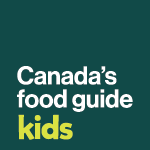Explore ways to connect Canada’s food guide to core knowledge and skill subjects. Exposing children to a variety of foods can help them become familiar with these items and provide opportunities for natural conversations about food and eating. Try these additional educational activities to support learning.
Tip: These activities are intended to support children’s learning in a variety of settings. They should not be interpreted as curriculum. Visit your province or territory’s ministry or department of education for information on curriculum.
On this page
Arts
Provide children with a variety of food flyers or magazines. Have them cut out pictures of foods to make a colour collage.
Challenge children to feature at least 3 different colour sections on their collage by grouping similarly coloured items together. For example, they could group together:
- beets
- cherries
- raspberries
- raw lean beef
Science
Ask children to choose a topic to explore related to food and the environment. Invite them to reflect on where these organisms get their water and nutrients. For example:
- Trees and plants: from the soil
- Marine life, like crab and fish: from plants and other marine life
- Insects, like bees: from plants and flowers
Mathematics
Invite children to create a poll to ask their peers about their favourite vegetable or fruit, whole grain food or protein food and present the results in a bar graph.
Social studies
Consider how food choices in Canada may vary based on where people live and the natural environment that is nearby. For example:
- seafood for those that live near the ocean
- fresh farm produce for those that leave near farmland
Discuss with children the foods that are most common in your region based on the natural environment.
Language arts
Ask children to write a poem, such as a haiku or limerick, on a certain food from Canada’s food guide. Poems can be about the foods themselves or touch on the process that food undergoes to get from farm to table.
Physical education
Ask children to line up into a single file. Explain that food items will be associated to different actions, for example:
- protein foods: jump to the left
- whole grain foods: jump to the right
- vegetables and fruits: jump back into a single file
Name different food items in a random order and get children to execute the actions associated with each item. Each child that does a wrong action must complete 5 star jumps, or another action, and then join the line again.
As children become comfortable with the different movements, you can add new actions. For example:
- kale: do a hop
- tofu: lie flat on the ground
- orange: sit on the ground and hold your knees to your chest
Second language studies
Set up a pretend grocery store. Ask children to choose different food items and name them in a second language to the cashier in order to purchase them.



